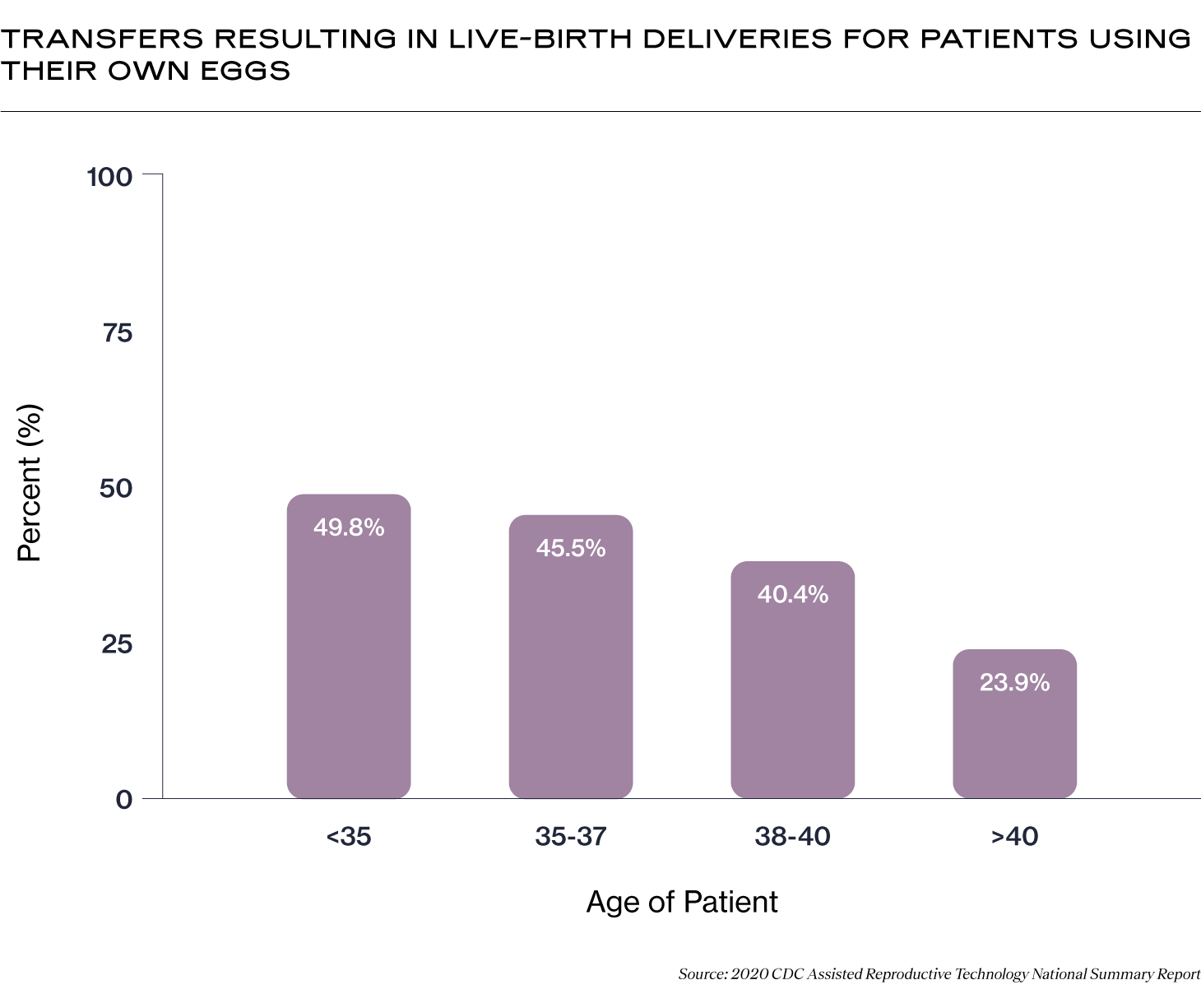Embryo Transfer Success Rates

Medically reviewed by Linda Streety, RN, BSN
When it's time for your embryo transfer (the last step of the in vitro fertilization (IVF) process), you may be understandably anxious to know whether or not it will be successful. Because your individual chance of success with IVF depends on many factors – from your hormone levels to any infertility diagnoses you may have – knowing the general success rate of embryo transfer for people your age is only of limited usefulness. Still, it's helpful to know how often embryo transfers result in a live birth.
Because maternal age is a major factor in the success of IVF, it’s important to note that the success rates below are measured by maternal age at the time of egg retrieval, not at embryo transfer.
How often are embryo transfers successful?
According to national information based on 110,029 ART cycles reported by the CDC in 2020, the IVF success rate for patients under 35 using their own eggs was just under 50%, and decreased for older patients. These numbers include all embryo transfers, whether fresh or frozen (1).

It’s important to note that these numbers are averages, and you are not an average! Many factors go into your chance of success with embryo transfer: the age of your eggs, quality of your embryos, endometrial receptivity, etc. You will get the best sense of your chance of success by talking to your clinician.
What is the success rate of the first embryo transfer?
According to SART data collected for 2020, first embryo transfer success rates decrease with age. We want to emphasize that these success rates are just for the first embryo transfer from an intended egg retrieval cycle; subsequent embryo transfers from the same egg retrieval could result in a positive outcome!
(You may be wondering, what do we mean by “intended egg retrieval”? An intended egg retrieval is when a person begins an ovarian stimulation cycle with the intent to retrieve eggs; this group of people includes those whose cycles were canceled or whose retrieval did not result in any eggs.)
Live births per egg retrieval for first embryo transfer
| Age | <35 | 35-37 | 38-40 | 41-42 | >42 |
|---|---|---|---|---|---|
| Live Birth Rate | 39.9% | 30.7% | 21.3% | 11.3% | 3.6% |
| Age: less than 35 | |
|---|---|
| Live Birth Rate | 39.9% |
| Age: 35-37 | |
| Live Birth Rate | 30.7% |
| Age: 38-40 | |
| Live Birth Rate | 21.3% |
| Age: 41-42 | |
| Live Birth Rate | 11.3% |
| Age: over 42 | |
| Live Birth Rate | 3.6% |
For a deeper dive into your potential chance of success, the graph below compares the first embryo transfer success rates for a fresh embryo transfer, a frozen embryo transfer, and a frozen embryo transfer with preimplantation genetic testing (PGT-A). Rather than look at your chance of success by age, this graph shows your chance of success according to the number of eggs retrieved during your ovarian stimulation cycle.

Day 3 vs. Day 5 embryo transfer success rates
Embryos can be transferred either on day 3 (cleavage stage) or day 5 (blastocyst stage) of development. The chart below, from a study of 564 completed IVF cycles, shows your overall chance of having a live birth for day 3 and day 5 embryos after transferring all the embryos created from a single egg retrieval (3). This overall chance of having a live birth is also known as the “cumulative live birth rate” (CLBR). The chart also compares fresh/frozen cycles (in which one embryo was transferred fresh and any other viable embryos were frozen for a later transfer), and cycles in which all the viable embryos were frozen before transfer.
| Fresh/Frozen CLBR | All Frozen CLBR | |
|---|---|---|
| Day 3 Embryos | 45.6% | 46.4% |
| Day 5 Embryos | 45.3% | 66.7% |
| Fresh/Frozen CLBR | |
|---|---|
| Day 3 Embryo | 45.6% |
| Day 5 Embryo | 45.3% |
| All Frozen CLBR | |
| Day 3 Embryo | 46.4% |
| Day 5 Embryo | 66.7% |
As you can see above, the cumulative live birth rate for cycles in which all the embryos were grown to day 5 and then frozen is higher than for the other cycles. This may be because you can conduct PGT testing on day 5 embryos, which must be frozen while testing occurs.
What determines my individual chance of success with embryo transfer?
Many factors impact your chance of success with embryo transfer. You and your clinician will consider all these factors as you decide how to proceed:
- Whether you want to do a fresh embryo transfer or frozen embryo transfer
- How many embryos to transfer at one time
- Whether you want to do PGT testing on your embryos
- Whether you need additional hormone medications to support your body before and after the embryo transfer procedure
As your clinician makes recommendations, they will be looking at your body’s hormone levels, your uterine lining, the quality of your embryos, your age, and any other factors that may impact your chance of success.
Because so many factors go into these decisions, the success rates above will only give you a limited sense of your chance of success with IVF, whether you choose to do a fresh or frozen transfer.
If you have not yet started IVF or egg freezing but are considering starting the process, it will be helpful to get your AMH (anti-müllerian hormone) tested to get a sense of your ovarian reserve (the remaining supply of eggs in your ovaries). You may also consult with your OB/GYN or a fertility specialist who can order an ultrasound to check your antral follicle count (AFC) and consult on any fertility issues you have that may impact your chance of success.
Recent Articles
References
-
“Assisted Reproductive Technology (ART) DataAssisted Reproductive Health Data: Clinic | DRH | CDC.” Nccd.cdc.gov, nccd.cdc.gov/drh_art/rdPage.aspx?rdReport=DRH_ART.ClinicInfo&rdRequestForward=True&ClinicId=9999&ShowNational=1.
-
“National Summary Report.” Www.sartcorsonline.com, www.sartcorsonline.com/rptCSR_PublicMultYear.aspx?ClinicPKID=0#patient-cumulative.
-
Zacà, Carlotta, et al. “Cumulative Live Birth Rate in Freeze-All Cycles Is Comparable to that of a Conventional Embryo Transfer Policy at the Cleavage Stage but Superior at the Blastocyst Stage.” Fertility and Sterility, vol. 110, no. 4, Sept. 2018, pp. 703–709, https://doi.org/10.1016/j.fertnstert.2018.05.012. Accessed 16 Apr. 2022.
Images:
“Assisted Reproductive Technology (ART) DataAssisted Reproductive Health Data: Clinic | DRH | CDC.” Nccd.cdc.gov, nccd.cdc.gov/drh_art/rdPage.aspx?rdReport=DRH_ART.ClinicInfo&rdRequestForward=True&ClinicId=9999&ShowNational=1.
Fanton, Michael, et al. “A Higher Number of Oocytes Retrieved Is Associated with an Increase in 2PNs, Blastocysts, and Cumulative Live Birth Rates.” Fertility and Sterility, Jan. 2023, https://doi.org/10.1016/j.fertnstert.2023.01.001. Accessed 27 Feb. 2023.
Zacà, Carlotta, et al. “Cumulative Live Birth Rate in Freeze-All Cycles Is Comparable to that of a Conventional Embryo Transfer Policy at the Cleavage Stage but Superior at the Blastocyst Stage.” Fertility and Sterility, vol. 110, no. 4, Sept. 2018, pp. 703–709, https://doi.org/10.1016/j.fertnstert.2018.05.012. Accessed 16 Apr. 2022.
Share this
Recent Articles

Learn everything you need to know about IVF
Join the newsletter for IVF education, updates on new research, and early access to Alife products.



